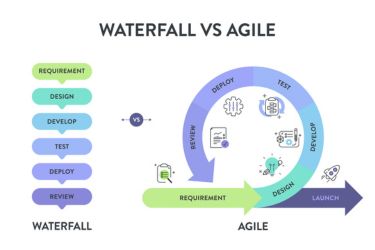Lean Six Sigma is a powerful approach used to improve processes, reduce waste, and enhance quality in various industries. By combining the principles of Lean manufacturing and Six Sigma, organisations can streamline their operations and achieve better results. This method promotes teamwork and systematic problem-solving, making it a valuable tool for anyone looking to improve their business practices.

As we explore Lean Six Sigma, we will highlight its core concepts, the different certification levels available, and the benefits it brings to organisations. We will also discuss how to effectively implement Lean Six Sigma within our teams and the skills needed to drive success. With practical examples and methodologies, we will demonstrate how this approach can lead to impressive improvements in efficiency and innovation.
Join us as we uncover the secrets of Lean Six Sigma and its impact across various sectors, providing insights that can help us all advance in our professional journeys.
Key Takeaways
- Lean Six Sigma improves efficiency by reducing waste and enhancing quality.
- Teams can gain certification at different levels to grow their Lean Six Sigma skills.
- This approach can be implemented across various industries to drive innovation.
Understanding Lean Six Sigma

We will explore the essential principles of Lean Six Sigma, focusing on the Lean way of thinking and the Six Sigma methodology. Understanding these concepts helps us improve quality and efficiency in our processes.
Principles and Foundations
Lean Six Sigma combines two important approaches: Lean and Six Sigma. Lean aims to eliminate waste in processes, making them faster and more efficient. This involves evaluating every step in a process to identify areas of waste, such as excess motion or waiting times.
Six Sigma, on the other hand, focuses on reducing variation and defects. This is achieved through a structured method called DMAIC, which stands for Define, Measure, Analyse, Improve, and Control. By addressing the root causes of problems, we can create more consistent and reliable results.
Lean Way of Thinking
The Lean way of thinking emphasises the importance of value stream mapping. This method helps us visualise the entire process from start to finish, allowing us to spot unnecessary steps and bottlenecks.
Key principles of Lean include:
- Value: What the customer wants.
- Value Stream: All the steps needed to bring a product to the customer.
- Flow: Ensuring a smooth movement of products or services.
- Pull: Producing only what is needed, when it is needed.
By focusing on these principles, we can create a culture of continuous improvement in our organisations.
The Role of Six Sigma Methodology
Six Sigma provides powerful tools to measure and improve quality. It uses statistical analysis to identify areas where we can reduce defects. For instance, we can apply techniques like Design of Experiments or Failure Mode and Effects Analysis (FMEA).
Using Six Sigma, we gather data to understand process variations better. This helps us identify potential issues before they lead to defects. By applying the DMAIC framework, we ensure that improvements are not only made but are also sustained over time.
Incorporating both Lean and Six Sigma enables us to develop a more effective approach to problem-solving and process improvement in our operations.
Core Belts and Certification Levels

In Lean Six Sigma, various belt levels indicate our expertise and roles in process improvement. Each belt has distinct training and responsibilities. Understanding these levels helps us determine our path in quality management.
Yellow Belt
The Yellow Belt is the entry-level certification in Lean Six Sigma. This level introduces us to the basic concepts and tools used in the methodology.
Individuals with a Yellow Belt typically gain knowledge about process mapping, problem-solving techniques, and basic data analysis.
They support project teams by participating in improvement initiatives while working under the guidance of Green and Black Belts. Certification usually involves attending a training course, followed by a brief exam. This foundational knowledge prepares us for more advanced levels of training.
Green Belt
The Green Belt is a significant step up from the Yellow Belt. This certification provides us with a deeper understanding of Lean Six Sigma tools and methodologies.
Green Belts often lead smaller projects and work on teams alongside Black Belts. They apply statistical methods to analyse process performance and recommend improvements.
Training typically includes workshops on various tools such as DMAIC (Define, Measure, Analyse, Improve, Control) and root cause analysis. Certification usually requires project completion and passing an exam, solidifying our skills in practical applications.
Black Belt
Individuals at the Black Belt level take on more complex project leadership roles. This certification demonstrates a high level of expertise in Lean Six Sigma principles.
Black Belts lead teams through larger projects and mentor Green Belts and Yellow Belts. They possess strong analytical skills and can manage significant initiatives that drive organisational change.
The training covers advanced statistical tools, project management, and change management techniques. Achieving certification requires completion of projects demonstrating significant process improvement, along with passing a comprehensive exam.
Six Sigma Black Belt
The Six Sigma Black Belt level represents the pinnacle of Lean Six Sigma mastery. This designation indicates exceptional skills in using advanced methodologies to solve complex problems.
Professionals with this certification often take on strategic roles within organisations, driving quality improvement initiatives at a high level.
Training includes extensive coverage of statistical analysis, process control methods, and leadership skills. Certification often necessitates a significant project that results in measurable benefits for the organisation, as well as successful completion of a rigorous examination. This level cements our role as leaders in the Lean Six Sigma community.
Implementing Lean Six Sigma in Organisations

Successfully implementing Lean Six Sigma in our organisations requires careful planning and a focus on our teams. This includes effective team management, clearly defined roles for project managers, and solid change management strategies.
Team Management and Involvement
We need to ensure all team members are engaged in the Lean Six Sigma process. This includes everyone from senior management to junior employees. Each person should understand their role in the improvement journey.
We can create cross-functional teams that bring together diverse skills. By doing so, we encourage collaboration and innovation. Regular meetings can help keep everyone aligned with our goals.
Additionally, providing training on Lean Six Sigma principles empowers our teams. Workshops and hands-on sessions can enhance their skills. This involvement fosters a culture of continuous improvement.
Role of Project Managers
Project managers play a vital role in Lean Six Sigma implementation. They must lead the project with clarity and purpose. Their responsibilities include setting clear objectives and timelines.
Project managers also need to communicate effectively with all stakeholders. This includes updating team members on progress and addressing any challenges that arise.
They should engage team members in identifying problems and brainstorming solutions. This inclusive approach not only improves outcomes but also builds trust among the team.
By establishing a supportive environment, project managers can inspire teams to embrace change.
Change Management Strategies
Change management is essential when implementing Lean Six Sigma. We must prepare our teams for new processes and practices.
One effective strategy is to communicate the reasons behind the changes. Understanding the benefits encourages acceptance and reduces resistance.
We can also create a feedback loop. This allows employees to share their experiences and suggestions. Listening to their voices helps us refine our approach.
Training sessions can also help ease the transition. By offering resources and support, we ensure everyone feels equipped to adapt.
By focusing on strong change management, we can make Lean Six Sigma an integral part of our organisational culture.
Lean Six Sigma Projects and Methodologies

In Lean Six Sigma, the choice of projects and how we measure success are crucial. We need to identify the right projects to maximise benefits and establish clear Key Performance Indicators (KPIs) to track our progress effectively.
Project Selection and Scoping
Selecting the right project is key to ensuring effective outcomes in Lean Six Sigma. We should focus on projects that align with our organisational goals. This should include improvements that impact customer satisfaction, reduce costs, or increase efficiency.
When we scope a project, we define its boundaries and objectives clearly. This involves asking questions like:
- What problem are we trying to solve?
- Who will be involved in the project?
- What resources do we need?
By gathering this information, we can avoid scope creep and concentrate our efforts on innovative projects that deliver measurable improvements.
KPIs and Measuring Success
Establishing useful KPIs is vital to gauge our project's success. These indicators help us monitor our progress and determine if we are achieving our goals. Common KPIs in Lean Six Sigma projects include:
- Defect rates: Measures the quality of the output.
- Cycle time: Tracks the amount of time to complete a process.
- Cost savings: Evaluates the financial impact of our improvements.
To effectively use KPIs, we should set specific, measurable targets. Regularly reviewing these metrics allows us to adapt our strategies and focus our resources effectively on what truly drives success in our Lean Six Sigma initiatives.
Benefits of Lean Six Sigma
Implementing Lean Six Sigma in our organisation can lead to significant improvements in both financial and non-financial aspects. We can also foster a culture of continuous improvement that drives success and efficiency across all departments.
Financial Benefits
One of the major advantages of Lean Six Sigma is cost reduction. By eliminating waste and optimising processes, we save money on resources. For example, reducing excess inventory means lower storage costs.
Another financial benefit is increased revenue. When we improve our product quality, it leads to higher customer satisfaction and potentially more repeat business. Additionally, faster production times can lead to higher output and sales.
Cost savings can be substantial. Research shows that companies typically see a return on investment (ROI) of 2:1 or more after implementing these strategies. This means for every £1 invested, we can expect to gain at least £2 back.
Non-Financial Benefits
While the financial gains are significant, the non-financial benefits should not be overlooked. Lean Six Sigma fosters a better working environment by involving employees at all levels in problem-solving. This engagement improves job satisfaction and promotes teamwork.
Moreover, we develop a strong focus on quality, which enhances our company’s reputation. Consistently delivering high-quality products builds customer loyalty and trust. This dual focus on employee satisfaction and customer service can improve overall workplace morale.
Finally, we can expect fewer errors and defects. This reliability not only aids in maintaining quality standards but also reduces the stress on our staff, making for a more positive workplace atmosphere.
Continuous Improvement Culture
Adopting Lean Six Sigma helps us create a culture of continuous improvement. We consistently look for ways to enhance our processes, which keeps us competitive in the market.
This culture encourages everyone in the organisation to share their ideas for improvement. By empowering our team, we foster innovation and adaptability. Regular training on Lean Six Sigma principles also ensures that our skills remain sharp.
We create a cycle of assessing, implementing, and reviewing changes. This ongoing commitment to improvement helps us respond quickly to changing market demands and customer needs, leading to long-term success.
By focusing on both financial gains and enhancing our workplace culture, we can ensure Lean Six Sigma is not just a set of tools, but a way of thinking that benefits everyone involved.
Lean Six Sigma Across Industries
Lean Six Sigma is a versatile approach that helps improve processes in various sectors. By combining efficiency with quality control, it benefits manufacturing, technology, and small to medium-sized enterprises.
Manufacturing Sector
In the manufacturing sector, Lean Six Sigma plays a crucial role in reducing waste and improving production efficiency. We focus on eliminating non-value-adding activities, which can cut costs significantly. For instance, techniques like Value Stream Mapping help us pinpoint areas that need improvement.
By using statistical methods, we can reduce defects and enhance product quality. Many companies see improvements in delivery times and customer satisfaction. The combination of Lean and Six Sigma ensures that we maintain high standards while optimising our processes. Success stories are common, with businesses reporting higher profitability and lower operational costs.
Technology and Digital Transformation
In the realm of technology, Lean Six Sigma can streamline processes related to software development and digital services. We employ Agile methodologies alongside Lean principles to enhance project management. This synergy accelerates delivery times, allowing for more responsive and efficient operations.
By applying data-driven techniques, we analyse user feedback to improve software products. This approach helps us identify bugs and user experience issues early in the development cycle. As a result, we can provide better services that meet customer needs effectively. Companies embracing these strategies tend to be more innovative and competitive in the tech landscape.
Application in Small and Medium-Sized Enterprises
Lean Six Sigma is not just for large corporations; it greatly benefits small and medium-sized enterprises (SMEs). These businesses often face unique challenges, such as limited resources. We implement Lean principles to optimise operations and minimise waste, allowing SMEs to compete effectively.
In SMEs, team engagement is vital. Lean Six Sigma fosters a culture of continuous improvement, encouraging all employees to contribute ideas. This leads to enhanced productivity and quality in products or services. Many SMEs that have adopted these practices report increased customer loyalty and improved financial performance, proving that Lean Six Sigma is essential for growth.
Developing Lean Six Sigma Skills and Careers
In today’s competitive job market, we recognise the importance of developing essential Lean Six Sigma skills for career success. This section focuses on key areas such as managerial skills, freelance consulting, and opportunities for career advancement.
Managerial Skills
To excel in Lean Six Sigma, we must cultivate strong managerial skills. These skills help in overseeing projects and leading teams effectively. Key managerial skills include:
- Decision-Making: Strong decision-making abilities allow us to make informed choices quickly.
- Problem-Solving: We need to identify issues and implement solutions efficiently.
- Team Collaboration: Building a cohesive team is vital for achieving project goals.
Mastering these skills contributes to successful implementation of Lean Six Sigma methods, leading to improved processes.
Freelance Consultants
Freelance consultants play a significant role in Lean Six Sigma. Many organisations look for experts who can bring specific skills without the long-term commitment of hiring full-time staff. As freelance consultants, we can offer:
- Specialised Knowledge: With our expertise, we can help organisations implement Lean Six Sigma practices tailored to their needs.
- Flexible Engagements: This allows us to work on various projects across different industries, broadening our experience.
Being a freelance consultant can be rewarding, providing us with opportunities to collaborate with diverse teams and build our professional network.
Opportunities for Career Advancement
Lean Six Sigma certification opens various paths for career advancement. As certified professionals, we often find opportunities in:
- Management Positions: Many companies value Lean Six Sigma skills for leadership roles.
- Project Management: We may lead projects focused on process improvement and efficiency.
- Training and Coaching: With our knowledge, we can train others in Lean Six Sigma methodologies.
These roles not only enhance our professional skills but also position us favourably in the job market. With continuous improvement as a core principle, we can leverage these opportunities to grow in our careers.
Driving Process Innovation and Efficiency
We focus on enhancing our processes to foster innovation and increase efficiency. By applying Lean Six Sigma methodologies, we can streamline our operations and improve the quality of our outputs, leading to substantial benefits for our organisation.
Improving Organisational Processes
In our quest for process innovation, we start by mapping existing workflows. This helps us identify inefficiencies and redundancies. By using tools such as value stream mapping and process flowcharts, we can visualise current processes and pinpoint areas for improvement.
Next, we implement strategies aimed at eliminating waste and optimising each step. Techniques like the 5S method (Sort, Set in order, Shine, Standardise, Sustain) help us maintain a clean and efficient workspace.
Furthermore, we encourage a culture of continuous feedback. Engaging our team in discussions about their experiences can uncover additional insights. This collaborative approach ultimately leads to more innovative solutions and streamlined operations.
Boosting Efficiency and Productivity
To boost efficiency, we analyse key performance indicators (KPIs) regularly. By measuring metrics such as cycle time, defect rates, and customer satisfaction, we gain valuable insights into our processes.
Implementing standardised procedures also plays a crucial role. When everyone follows the same steps, we reduce variation and increase output quality. Continuous training ensures our team stays skilled in new methodologies.
Additionally, we leverage technology to automate repetitive tasks. Automation can free up our team’s time for more complex, value-added activities. This shift not only enhances productivity but also promotes job satisfaction among our employees, creating a more engaged workforce.
Through these strategies, we make a strong impact on our efficiency and set the stage for ongoing process innovation.
Frequently Asked Questions
In this section, we address common queries regarding Lean Six Sigma. These include topics such as certification costs, methodology differences, and the principles that drive success in projects.
What are the different belt levels in Lean Six Sigma, and what do they signify?
Lean Six Sigma uses a belt system to indicate the level of expertise. The most common levels are White Belt, Yellow Belt, Green Belt, Black Belt, and Master Black Belt. Each level represents a different depth of knowledge and management responsibility in the methodology.
What is the average cost of obtaining a Lean Six Sigma certification?
The cost of Lean Six Sigma certification varies widely. Typically, certification can range from a few hundred to several thousand pounds. This depends on the programme provider and the certification level chosen.
How does the Lean Six Sigma methodology differ from traditional Six Sigma?
Lean Six Sigma combines Lean's focus on waste reduction with Six Sigma's emphasis on quality improvement. Traditional Six Sigma mainly aims at reducing variation and defects, while Lean focuses on streamlining processes for efficiency.
What principles underpin Lean Six Sigma, and how do they drive process improvement?
The core principles of Lean Six Sigma include customer focus, data-driven decision-making, and continuous improvement. These principles guide teams in identifying inefficiencies and implementing effective solutions.
What are the prerequisites for enrolling in a Lean Six Sigma course?
Prerequisites can vary by course, but generally, there are no formal requirements for entry-level certifications. For advanced levels, some programmes may require prior certification or experience in process improvement methodologies.
How can the effectiveness of a Lean Six Sigma project be measured?
We can measure the effectiveness of a Lean Six Sigma project using various metrics. Common methods include tracking process improvement results, customer satisfaction ratings, and financial savings achieved through increased efficiency.





















